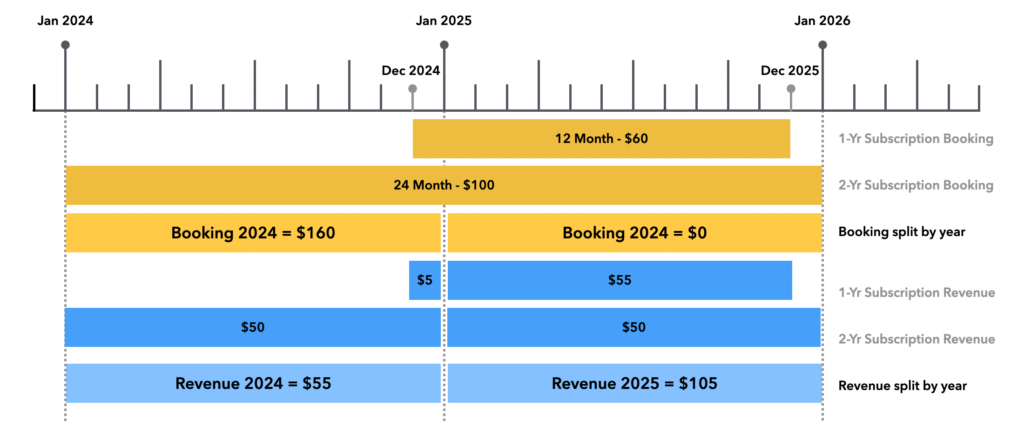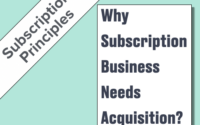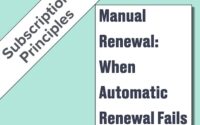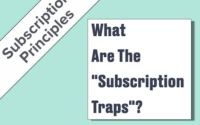In a subscription business, what is the difference between Booking and Revenue?
Summary
Booking is the money counted at the time I received it.
Revenue is the money counted at the time the service is realized or product is delivered.
A subscription business works thanks to subscribers who pay regularly for a service.
Be careful. There are nuances in counting incoming money and subscribers.
1. Booking ≠ Revenue for subscriptions
Revenue is recorded during the period in which the service is performed, and not when the money is received.
In application of this principle, I calculate my revenue by dividing the booking by the duration of the subscription.
Concretely, when I sell a 1-year subscription at $60, I have an income of $5 each month for 12 months or $15 for 4 quarters.

Graph #1 : revenue split by quarter
2. Consequences on how to manage a subscription business
Here’s an example. I manage a business and must inform partners or shareholders of quarterly results.
a. Deferred income
I sold a 1-year subscription at $60 sold in December 2024: I earned $5 in 2024 and $55 in 2025.
I sold a 2-year subscription at $100 sold in January 2024: I earned $50 in 2024 and $50 in 2025.
In this case, I sold 2 subscriptions in 2024, for a booking of $160. However, my income is $55 in 2024 and will be $105 in 2025.
As I charge before providing the service, the revenue of the current year is mainly a reflection of past activity.

Graph #2 : booking and revenue split by years
b. Retroactive income
I allowed a payment delay to a customer. His subscription ended at the end of December 2023, he couldn’t pay me immediately. He agreed to pay me in February 2024 and I agreed not to suspend his subscription. I receive his payment in February 2024, and I must recognize a portion in January 2024.
Later, my customer service gave 3 free months to a dissatisfied customer. The initial price of the subscription was $60 for 1 year, or $5 per month. Now, this subscription is $60 for 15 months, or $4 per month.
From a technical point of view, offering free months of subscription consists of shifting the end date of the subscription by a few days.
From an accounting point of view, it’s much more complex.
Calculating revenue becomes more complicated when my actions affect the past.
3. Consequences on offers
I should adapt my commercial offers depending on whether my objective is to increase bookings or revenue.
Let’s take three types of offers:
- A 2-year subscription offer with discount
- A cross-sell offer for another product
- A free up-sell offer
A multi-year offer will generate a little less than double the booking but the revenue will be recognized over 2 years. In the end, the booking is up ⬆️ but the revenue is down ⬇️.
A cross-sell offer adds another product. Whether the product sold in cross-sell is a subscription or not, this will increase the booking ⬆️ and the revenue ⬆️.
A free up-sell offer has no impact on the booking at the time of purchase. At renewal, a superior product will be billed. The booking ⬆️ and the revenue will be up ⬆️. However, depending on the expiration date of the subscription, this increase will materialize sooner or later.
Key takeaways
- A discount can help increase the booking. But any discount impacts revenue downwards 📉.
- Before launching any offer, I check if it really helps achieve my goals. The KPIs must be influenced in the desired direction.
- The timing of an offer is important. I think about targeting customers according to their remaining subscription time in order to obtain the effect on the current or next quarter.



